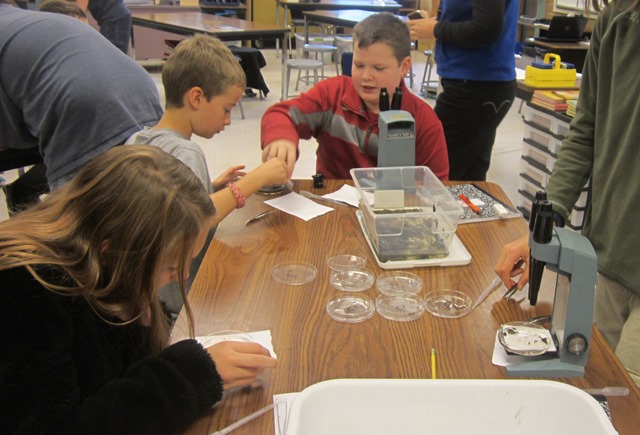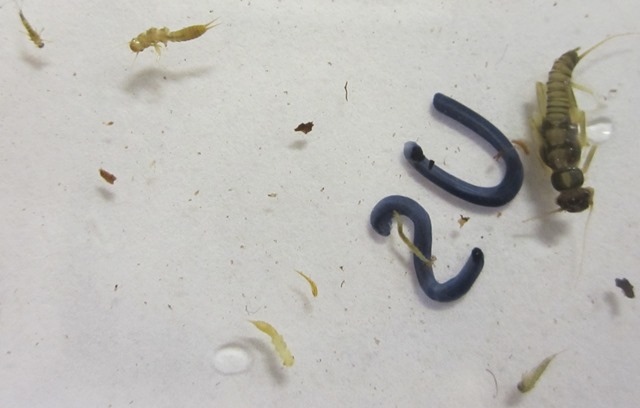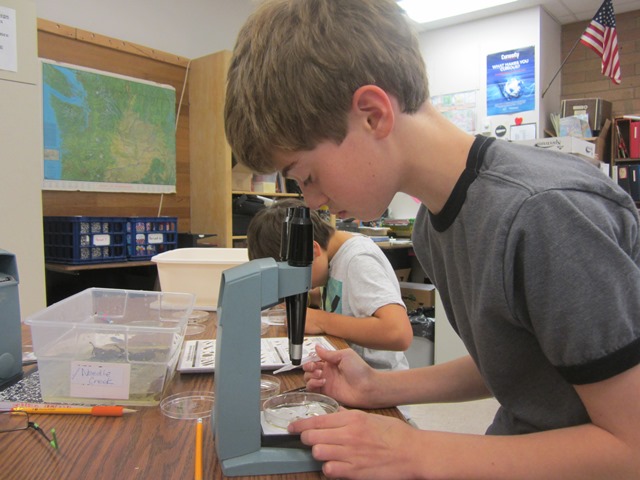A shorter version of this article recently appeared in the November 13th issue of the Beachcomber.
“I got another one!” “Look at this!” “It’s a mayfly — see the tails!” “I don’t understand why kids don’t like science… This is the best lab ever.”
These comments echoed through a McMurray Middle School science classroom last month as sixth graders eagerly sifted through leafy debris from Shinglemill and Needle Creeks water samples. They were working to find and identify stream-dwelling invertebrates — in this case mostly tiny insect larva, some barely visible to the naked eye — which scientists use to gauge water health. Vashon Nature Center, as part of a Vashon-Maury Island Groundwater Protection Committee study, brought invertebrates from local streams into six science classrooms where, with the help of local biologists, hand magnifiers, keys and microscopes, 100 students learned to tell the difference between a caddis fly and a true fly, and what their existence has to do with healthy salmon populations.

Cara Snodgrass, Logan Proust, and Jack Zimmerman explore invertebrates from Needle Creek. photo by: Bianca Perla

Expert scientists like Karen Fevold, pictured here, worked with students to identify and sort invertebrates. photo by: Bianca Perla
By the time they were through, the students had counted 700 total invertebrates, identified four species never before recorded in Shinglemill and found native freshwater snail eggs, which prompted local scientists to further probe island creeks to research snail dispersal methods — another important stream health indicator.
“I didn’t know a whole bunch of these little guys lived in the streams,” said sixth grader Nelson Giorgini. “It was cool to learn about them and what they do, and see the difference between one stream and another.”
Sixth-grade student Sean Robertson said he enjoys science class appreciated being asked to participate in an actual study: “It’s cool that they let kids our age do that sort of thing. I’ve never done it before and I think it’s pretty awesome.”
Giorgini and Robertson volunteered with several classmates to create an overview of the students’ invertebrate findings, which they will present to the Groundwater Protection Committee next week.
“I’ve always wanted to have an experience where kids get to be citizen scientists because it’s real life and it’s making an impact,” said Gay Roselle, a McMurray science teacher. “One of the issues with teaching about environmental problems is that sometimes we don’t discuss the solutions. It was great to have the opportunity for kids to explore these issues and learn about some positive things that are being done to address them.”
Bianca Perla, who founded Vashon Nature Center to connect islanders with local nature and collect data on island flora and fauna, chose science as a career path after a high school science class led her literally into Puget Sound to improve salmon habitat.
“I didn’t think much of science until I saw wildlife biologists in the field,” she said. “It made science come alive for me.”
Perla said citizen science gives people a new appreciation for their home and strengthens the community as a whole.
“It increases people’s connection to the place where they live,” she said. “The environment is easier to protect when you have citizens that know what’s going on because they’re out there walking the beaches and the forests. They have a certain level of environmental literacy that makes the whole community more resilient and less vulnerable to environmental degradation.”
From a scientific standpoint, citizen science provides important information, which Perla explained would otherwise fall through the cracks: Citizen science can be conducted with less money than needed for a government agency or university study, and the collected data augments the efforts of other agencies.
“Scientifically the island is important because everything is connected,” Perla said.
The ecologist noted that Vashon is important regionally from an ecological perspective — salmon from as far away as the Skagit River eat along the island’s shores, and migratory birds from South America and California breed in island forests and waters. Vashon and Maury makes up half the undeveloped shoreline in King County and has some of the last remaining good habitat for many species.
“We’re just a speck on the map, and when it comes to large-scale conservation projects we slip under the radar,” she said.
Vashon High School Science Chair Elisabeth Jellison is drawn to the community service element of citizen science. Inspired by a science education journal article, this year she had a new assignment for her biology students: All 165 of them were asked to complete a 15-hour citizen science project over the semester.
“Science is here to serve us and make our lives and the world we live in better,” she said, explaining she thought the project was a good way to show students that science was relevant to their lives.
“You don’t need a PhD or even a high school diploma, you just need to be able to look at things and follow directions. It’s something they can do no matter what they know,” she said.
For her project, freshman Eva Anderson chose to work with Vashon Nature Center to monitor recent plantings at Maury Island Marine Park, a place she often rides on horseback. Her job is to measure plantings such as Douglas fir and snowberry, and record the results so King County will have data about the success of various planting methods.
“I realized how it’s not just doing something, but also seeing how it helps,” she said. “It’s interesting to figure out what grows where and why.”
Sophomore Alina Brown has always been curious about a wetland in her neighborhood that comes to life each spring with a symphony of frog song, so for her project she designed a research study to explore its health. While collecting plant and water samples, she’s been impressed by the size of the cattails and grasses, and with the number of dragonflies on sunny days.
“Citizen science helps us as students know more about where we live and possibly make a difference in our area, which I think is really cool,” Brown said. “If the test results show the place is polluted, I hope to be able to find a way to clean it up and bring it to 100 percent in terms of health.”
The diversity of the high school projects is impressive, and Jellison is excited to see some kids finding a true passion for their projects. One group of students volunteered to help the research project Sound Citizen do water quality testing; the scientists seven invited the teens to tour their lab at University of Washington Tacoma. Some students joined the county’s Green Schools Program to help ensure the new high school follows conservation and recycling best practices. Others are setting up a weather station at Chautauqua Elementary School, and several have joined online studies where they are cataloging cancer cells or recording animals roaming Africa’s Serengeti plains.
“This is opening a lot of doors for kids who would have never thought of doing anything like this,” Jellison said. “Ten years from now they might not remember the stages of mitosis, but I think they will remember meeting people outside class, counting the salmon or volunteering in the park.”
Citizen science offers the rare opportunity for students to have real-world experiences.
“It’s giving students an opportunity to take our content knowledge and utilize science skills we’ve developed and apply them to our world so we can be powerful in how we engage with our neighbors, with our environment and as global citizens,” said Roxanne Lyons, director of instructional services for Vashon Island School District. “They’re learning that their actions matter and that the health of our natural world in large part depends on our actions. It’s tricky for us to help kids reach that level of application in their learning in the classroom; citizen science is one powerful way we can get that at a deep level.”
Students will present their work at the Groundwater Protection Committee Meeting on Monday November 18th at 6 PM at the Land Trust building. Anyone is welcome to attend.


